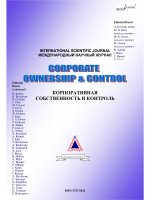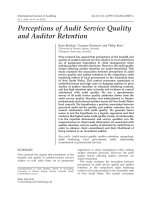Achieving the balance between service quality and price
Bạn đang xem bản rút gọn của tài liệu. Xem và tải ngay bản đầy đủ của tài liệu tại đây (557.3 KB, 172 trang )
ACHIEVING THE BALANCE BETWEEN SERVICE
QUALITY AND PRICE
CAO CHAOLAN
NATIONAL UNIVERSITY OF SINGAPORE
2005
ACHIEVING THE BALANCE BETWEEN SERVICE
QUALITY AND PRICE
CAO CHAOLAN
(B.Eng., NPU)
A THESIS SUBMITTED
FOR THE DEGREE OF MASTER OF ENGINEERING
DEPARTMENT OF INDUSTRIAL & SYSTEMS
ENGINEERING
NATIONAL UNIVERSITY OF SINGAPORE
2005
Abstract
Quality and price are considered as two important elements of marketing mix. It was believed that
the higher quality is, the higher customer satisfaction is and thus the higher purchase intention is.
However, it was also accepted that price was a motivator for customers’ buying decision making.
Recently, value which is to achieve the balance between service quality and price attracts more
attention in research world, since it seems that customers put more emphasis on value when
making buying decisions. Nonetheless, among quality, value and price, which element, that
customers value more for their buying decisions remains untouched. Through a survey and the
used of MANOVA and ANOVA, this paper investigates this important issue and factors that
influence the decision by consumers that could help companies to develop a proper marketing
strategy.
Key word: customer value, consumer behavior, airlines
i
ACKNOWLEDGEMENT
The author would like to show her deepest appreciation to her main supervisor Prof. Goh Thong
Ngee and project supervisor Prof. Xie Min for their critical comments and professional guidance
throughout the course of the project.
In addition, the author would also like to thank Dr. Chai Kah Hin for accepting her to attend his
research group discussion.
Furthermore, the author especially would like to express special gratitude to her parents for
incessant encouragement throughout the study.
At last, thanks also are given to my friends Philippe, Henry and Tingting, as well as other seniors
and juniors for sharing weal and woe with me.
ii
CONTENTS
ABSTRACT………………………… ………………………………………………… (i)
ACKNOWLEDGEMENT……………………………………………………………… (ii)
CONTENTS……………………………………………… (iii)
LIST OF FIGURES……………………………………… (v)
LIST OF TABLES…………………………………………………………………. … (vi)
CHAPTER PAGE
1. INTRODUCTION
1.1 Research Background………………………………………………… 1
1.2 Research Objective and Structure of the Thesis ………………………. 3
2. LITERATURE REVIEW
2.1 Introduction……………………………………………………………… 5
2.2 Understanding Consumer Behavior-Road to Success…… 5
2.3 Three Models of Buying Behavior………………………………………… 6
2.4 The Stages of Buying Decision Processes………………………………… 9
2.5 Dimensions of Purchase Intention…………………………………………. 11
2.6 Factors Affecting the Consumer Decision Making……………………… 12
2.7 Influences on Consumer Decision Making… 19
2.8 Customer and Their Needs Typology……………………………………… 26
2.9 Gap and Research Questions…………………………… ………… … 30
3. FORMULATION OF HYPOTHESES
3.1 Factors Affecting Consumer Behavior…………………………………… 34
3.2 Conclusion………………………………………………………………… 38
4. RESEARCH METHODOLOGY DEVELOPMENT
4.1 Introduction……………………………………………………………… 40
4.2 Questionnaire Design Methodology………………………………………. 40
4.3 Questionnaire Structure…………………………………………………… 42
4.4 Questionnaire Translation…………………………………………………. 43
4.5 Measures…………………………………………………………………… 43
4.6 Targeted Population and Survey Implementation…………………………. 46
4.7 Analysis Methodology…………………………………………………… 48
4.8 Conclusion……………………………………………… 55
5. ANALYSIS OF RESULTS
5.1 Introduction………………………………………………………… … 56
5.2 Preliminary Analysis……………………………………………………….56
5.3 Descriptive Analysis………………………………………………………. 59
5.4 Manipulation of MANOVA and ANOVA………………………………… 69
5.5 Summary………………………………………………………………… 79
iii
6. DISCUSSION
6.1 Introduction……………………………………………………………… 81
6.2 Research findings………………………………………………………… 81
6.3 Future Airline Industry – Mixed Business Model……………………… 105
6.4 Conclusion………………………………………………………………… 111
7. CONCLUSION
7.1 Introduction………………………………………………………………….113
7.2 Summary of Research Findings…………………………………………… 113
8. IMPLICATIONS FOR SERVICE DEVELOPMENT
8.1 Implications and Strategic Insights in Airline Industry……………… … 117
8.2 Application in Other Areas……………………………………… ……… 123
9. LIMITATIONS AND FUTURE DEVELOPMENTS
9.1 Design Questionnaire More Scientifically………………… … ……… 128
9.2 Limited Targeted Population………………………………… ……………. 130
9.3 Limited Affecting Factors in Research……………………… ……………. 131
9.4 Limited Research Field… ………………………………… …………… 132
REFERENCES…………………………………………………………………………. 134
APPENDICES
A1: Questionnaire in English……………………………………………………158
A2: Questionnaire in Chinese………………………………………………… 160
A3: Summarization of the Survey Data………………………………………… 162
iv
LIST OF FIGURES
Figure
Page
2.1 : Stimulus-response model……………………………………………………… 9
2.2 : Five-Stage model of the consumer buying process……………………………… 11
2.3 : KANO Model……………………………………………………………… … 27
3.1 :
Factors affect the consumer behavior 39
4.1 : Hotelling’s T (Simplest MANOVA)……………………………………………… 51
5.1 : Nationality summary chart…………………….………………………………… 57
5.2 : Income chart…………….……………………………………………………… 58
5.3 : Gender chart…………………….……………………………………………… 59
5.4 : Category of customers……….……………………………………………… … 60
5.5 : Categories of customers from four countries 62
5.6 : Customers’ preference on Airlines based on nationalities……………………… 63
5.7 : Categories of customers based on gender……………………………………… 64
5.8 : Customers’ preference on Airlines based on income……………………………. 65
5.9 : Categories of customers based on income………………………………………. 66
5.10: Customers’ preference on Airlines based on purpose……………………………. 68
8.1 : Removal of services with the KANO model…………………………………… 121
v
LIST OF TABLE
Table Page
2.1 : Reviews of literature on some factors influencing consumer behavior………… 18
2.2 : Comparison between No-frills airlines and flag airlines………………………… 31
5.1 : Choice among FA, EA and BA………………………………………………… 60
5.2 : Choice among FA, EA and BA based on nationality…………………………… 62
5.3 : Choice among FA, EA and BA based on income……………………………… 65
5.4 : Customers’ preference based on purpose of flying……………………………… 68
5.5 : MANOVA summary……………………………………………………………… 69
5.6 : Correlation Test………………………………………………………………… 70
5.7 : ANOVA for Flag Airlines………………………………………………………… 71
5.8 : Pairwise Comparison for Flag Airlines………………………………………… 72
5.9 : ANOVA for Economical Airlines………………………………………………… 74
5.10 : Pairwise Comparison for Economical Airlines………………………………… 75
5.11 : ANOVA for Budget Airlines…………………………………………………… 77
5.12 : Pairwise Comparison for Budget Airlines……………………………………… 78
7.1 : Hypotheses testing summary……………………………………………………. …… 115
8.1 : Proposed future research fields………………………………………………… 126
vi
1
CHAPTER 1
I
NTRODUCTION
1.1 RESEARCH BACKGROUND
As business competition intensifies and customers become more mature, the interests of
researchers, as well as practitioners, in purchase intention and its affecting factors
heighten. Because only after understanding why customers choose certain kinds of
products or services can companies know the direction where they would better develop
their services to cater for demanding customers.
The relationship between service quality, price, value and purchase intentions has
confused the research world for a long time. Some researchers believe that high service
quality leads to purchase intention (Sawyer and Dickson 1984; Zeithaml 1988, Ong
1999). Meanwhile, others hold the opposite view that high service quality does not
necessarily attract customers to patronize (Dodds and Monroe 1985; Zeithaml 1988,
Chang and Wildt 1994), and they put value as a media construct between quality and
purchase intention. By the same token, when referring to prices, it is difficult to decide
whether high prices or low prices lead to purchase intention. Researchers believe that a
positive relationship has been observed between price and perceived quality (Zeithaml
1988; Rao and Monroe 1989; Chang and Wildt 1994). Since perceived quality leads to
2
purchase intention, according to these researchers, high price, to some extent, should
have positive influence on customers’ purchase intention. However, in the real situations,
it is the low price that attracts customers’ attention more. Apart from the above two
aspects, one popular point of view in the purchase intention is that high customer value
directly influences customers’ purchase intention. Durvasula et al. (2004) proposed that
service quality had an indirect relationship with behavioral outcome measures via
satisfaction and value. However, value involves tradeoff of costs and benefits, making it
more difficult to measure (Holbrook and Corfman 1984). This is why many researchers
are more willing to believe in direct relationship between perceived quality and purchase
intention.
This confusion happens in the real world as well, e.g. airline industry. Before
deregulation, service quality of the airline (Flag Airlines) undoubtedly was the main
affecting factor in customers’ choices of airlines, since the price was controlled by the
authorities. Not long after the deregulation, due to the overcapacity of the industry,
airlines lowered their prices by more than half to maintain the market share. Many
Budget Airlines gained their fame at that time. Initially, the pricing strategy attracted a lot
of passengers. But as the customers became more mature, they were more likely to
choose airlines that achieve the balance between service quality and prices (Economical
Airlines), because of their needs and price sensitiveness. Until now, there is no paper
dealing with the issue that whether customers prefer Flag Airlines, Economical Airlines
or Budget Airlines. As well, the question that what factors influence their choices of
airlines remains untouched.
3
1.2 RESEARCH OBJECTIVE AND STRUCTURE OF THE THESIS
This paper aims to find out what will exert more influences on customers’ choices,
quality, price or the balance between quality and price - value. Furthermore, the paper
tries to explore factors that bring significant differences in customers’ buying behavior.
The paper is arranged in 7 sections. In Chapter 2, we present an overview of the
literature review. The purpose of this chapter is to review and summarize the previous
studies related to consumer behavior, as well as the relationship between purchase
intention, service quality, pricing strategy and customer value. After the review, the
research gap, together with the research questions, is identified. Hypotheses are
developed in Chapter 3. The aim of this chapter is to come up with some hypotheses
which could provide answers for the research questions raised in the previous chapter. In
Chapter 4, we will begin by describing the questionnaire structure and questionnaire
translation. Next, we will introduce two groups of dependent variables which are used to
determine the willingness point of choosing one type of airlines and the category that the
customer belong to. Finally, we will explain who our targeted surveyees were and how
we conducted the survey. Chapter 5 focuses on the results drawn from the questionnaire
data. we will present some preliminary analysis of the respondents, their nationality,
income and gender and alsol show some descriptive results. Using MANOVA and
ANOVA analysis as a means of comparison, we examine into how factors influence
customers’ choices of airlines.
4
in chapter 6, we discussed the research findings are in depth Within the discussion, we
will touch on issues such as Value-conscious customers’ dominance, quality-conscious
customers’ decrease and price-conscious customers’ emergence .Further, we will explore
nationality, income, gender and flying situations’ influences on customers’ choices will
be explored. At last, the discussion is related to the hypotheses proposed before. Chapter
7, 8 and 9 will present a summary of research findings, and provide the implications and
limitations of the study. At last, several directions for the further studies will be suggested
5
CHAPTER 2
L
ITERATURE REVIEW
2.1 INTRODUCTION
The purpose of this chapter is to review and summarize the previous studies related to
consumer behavior, as well as the relationship between purchase intention service quality,
pricing strategy and customer value. After the review, the research gap, together with the
research questions is identified. In this chapter, first we will accentuate the importance of
researching into consumer behavior. Then we will present some models of consumer
behavior. After that, we will list the dimensions of consumer behavior and discuss on
stages of the buying decision process. Next, factors and influences on consumer behavior
will be highlighted. Additionally, the relationship between purchase intention and service
quality, pricing strategy, customer value will be described. Finally, in the light of
research gap, two research questions will be formulated.
2.2 UNDERSTANDING CONSUMER BEHAVIOR – ROAD TO SUCCESS
The most important contributor to the success of an organization is a satisfied customer
(e.g. Rajesh & Uday, 2004). Therefore, the knowing of consumers and their purchasing
behavior is essential to successful marketing, since it enables service companies to offer a
service mix that consists of attributes most valuable to the prospective customers (Mittall
et al., 2001).
6
Consumer behavior involves how individual, groups, and organizations select, purchase,
use, and dispose of goods, services, ideas, or experiences to satisfy their needs and
desires (Kotler, 2000). Moreover, the process can be considered as a learning cycle. This
cycle includes the decision processes that precede and determine buying behavior
(Blackwell, Miniard & Engel, 2000), as well as feedbacks from the purchase decisions
which will be used as attitudes towards a certain brand or information for the next
decision process.
2.3 THREE MODELS OF BUYING BEHAVIOR
According to Oliver (1995), models can help to abstract, simplify and display a huge
number of ideas in an economic way. Thus, the advantages of showcasing weakness in
the definition of variables and exploring needed new variables, lead to the development
of several models. In the history of model developing, Nicosia Model (Nicosia, 1966),
Howard-Sheth Model (Howard & Sheth, 1969), Engel-Kollat-Blackwell Model with the
short form of EKB Model (Engel, Kollat & Blackwell, 1973), revised EKB model (Engel,
Blackwell & Miniard, 1993), Stimulus-Response Model have been or are being largely
accepted by both researchers and practitioners.
In Nicosia’s Model, consumer decision process starts from stimulus, the determinant of
behavior. Stimulus has two forms of existence, internal and external. Geography,
occupation, education, religion, race, income, prices, products, advertising and so forth
belong to external stimuli. After stimulated by external variables, customers still have to
be triggered by internal stimuli, which are personality, personal value and so on. The two
7
stimuli together could enable the mental process to translate themselves into motives,
which is the driving force to buying behavior. At this point, customers make a decision
on primary purchase which is related to product choice and selective purchase which is
related to brand choice. After consumption of the product, customers will react to both
the product and the brand, and the positive or negative reactions go back to modify the
intensity and nature of the motives.
However, there is a contradiction in the model’s assumptions (Rau & Samiee, 1981). In
his model, Nicosia assumed that neither the firm nor the consumer had any history
directly relevant to the content of a firm’s message. It seems not practical and realistic
unless it is used for new product or brand introduction.
Howard & Sheth (1969) presented a buyer behavior model to explain rational brand
choice behavior. The model of Inputs>Perceptual constructs>Learning
constructs>Outputs is based on Plato’s
Information>Cognitions>Affect>Behavior>Satisfaction (ICABS) hypothetical constructs
and overt behavior (Demirdjian, 2004). Similar to Nicosia’s model, Howard-Sheth model
starts with stimulus as well, although the name has been changed to Stimulus ambiguity.
There are three stimuli, which are Significative (quality, price, distinctiveness, service
and availability of products which are experienced by customers through shopping
activity), Symbolic (quality, price, distinctiveness, service and availability which are from
information source such as advertising) and Social (family, reference groups and social
class). The stimuli ambiguity will arouse attention and overt search later. Overt search
8
could have certain effects back on the stimuli, while attention leads to perceptual bias
arising from for example, buyers’ age. Buyers’ perceptional bias will produce different
motives and choice criteria, as well as brand comprehension which could be enhanced by
customer satisfaction. After that, buyers will form their attitudes towards the brand and
decide whether to buy or not.
Still, there are some problems in Howard-Sheth model. Rau & Samiee (1981) found out
that the input variables and output variables were not well identified. As well, the
definition of these factors was not done. Furthermore, it was confusing in the way the
process translated inputs into outputs, which made the application of this model
complicated.
EKB model is well known for its comprehensiveness and ease to follow (Demirdjian,
2004), although the EKB model seems more adept in displaying relationships between
and among variables rather than predicting behavior (Reidenbach, 1980). The model
showcases well the components of decision making, input, information processing, a
decision process, decision process variables, and external influences, together with the
relationships and interactions among them. Engel et al. (1993) identified two categories
of variables influencing buyers’ decision process: Environmental Influences and
Individual Differences. Environmental Influences include Culture, Social, Class,
Personal Influences, Family, Situation; while Individual Differences include Consumer
Resources, Motivation & Involvement, Knowledge, Attitudes, Personality, Values &
Lifestyle.
9
After decades of development of Consumer Behavior Model, nowadays, the most popular
and acceptable model is Stimulus-Response Model (See Figure 2.1) (Kotler, 2000). At
first, marketing and other stimuli go into the customer “black box” and come out as
consumer responses. The “black box” contains two modules of buyers’ characteristics
and the decision-making process. The buyer’s characteristics have an influence on how
he or she perceive the incoming stimuli; while the decision making process determines
what buying behavior will be fulfilled.
Figure 2.1: stimulus-response model (Source: Kotler, 2000)
2.4 T
HE STAGES OF BUYING DECISION PROCESS
Several researchers tried to model the buying decision process in stages. Engel et al.
(1993) proposed the buying decision process in the order of Need Recognition, Search,
Alternative Evaluation, Purchase, and Outcomes which are dissatisfaction or satisfaction.
Stimuli
Buyer’s
characteristics
& decision
process
Buyer’s
decision
Marketing stimuli:
z Product
z Price
z Place
z Promotion
Other stimuli:
z Economic
z Technological
z Political
z Cultural
Characteristics:
z Cultural
z Social
z Personal
z Psychological
Decision Process:
z Problem Recognition
z Information Search
z Evaluation of alternatives
z Purchase decision
z Post
p
urchase behavio
r
Decision:
z Product
choice
z Brand
choice
z Dealer
choice
z Purchase
timing
z Purchase
amount
10
Later, Oliver (1995) in his book put the process as Problem Recognition, Information
Search, Evaluation of Alternatives, Purchase Decision, and Outcomes of Purchase & Use.
Recently, Hisrich (2000) presented the process almost in the same way: Needs
Recognition, Information Search, Information Evaluation, Purchase Decision, and
Postpurchase Behavior. All the research works imply that consumers pass sequentially
through all five stages in buying a product (see figure 2.2).
However, due to the different types of buying behavior and differences between the
buyers themselves in terms of personality, knowledge and so on, there might be some
differences in the experienced stages of the buyers’ decision processes. Consumers may
skip or reverse some stages (Putsis, 1994). For example, a consumer who has been loyal
to a brand does not need the stages of Information Search and Evaluation of Alternatives
(Hart, C. & Dewsnap, B., 2001). Additionally, for low-involvement products which
mostly are low-cost, frequently purchased products, the buying process begins with brand
beliefs formed by passive learning and is directly followed by purchase behavior without
postpurchase evaluation (Kotler, 2000). Kotler (2000) also pointed out that the reversing
of some stages most probably happens in the routine purchase.
11
Figure 2.2 Five-Stage Model of the Consumer Buying Process
2.5 DIMENSIONS OF PURCHASE INTENTION
Nowadays’ research works on purchase intention mostly are based on the five dimensions
of purchase intentions (Zeithaml et al., 1994, Parasuraman et al., 1996). They suggested
that there were five dimensions which were loyalty to the company, propensity to switch,
willingness to pay more, external response to problem, and internal response to problem.
Later in Bloemer et al.’s (1999) research work, they recommended an improved way of
Problem
recognition
Information
search
Purchase
decision
Postpurchase
behavior
Evaluation of
alternatives
12
defining dimensions of purchase intention. They put Loyalty to the company and
Propensity to switch together, and replaced them with Repurchase intentions.
Additionally, other three dimensions seemed the same in meaning, although different in
expression, price sensitivity, word-of-mouth communication, and complaining behavior.
There are many other papers discussing on the dimensions (e.g. Nakata & Sivakumar,
1996, 1999; Furrer et al., 2000).
2.6 FACTORS AFFECTING CONSUMER DECISION MAKING
2.6.1 CATEGORY OF FACTORS
According to the Stimulus-Response Model, there are four categories of factors that
impact the customers’ purchase intention: cultural factors, social factors, personal factors
and psychological factors (Kotler, 2000). Cultural factors include culture, subculture, and
social class; social factors are reference groups, family, and social roles and statuses;
personal factors take age & stage in the life cycle, occupation and economic
circumstances, as well as life style into consideration; psychological factors focus on
motivation, perception, learning, and beliefs and attitudes. Because most of companies
struggle towards a global stage where players are from different backgrounds and
cultures, researches into culture’s influences on consumer behavior have draw more
concerns than other influencing factors (Sojka and Tansuhaj, 1995).
2.6.2 C
ULTURAL FACTORS
Numerous studies have compared the different behaviors of consumers from different
nationalities, religions, racial groups, geographic regions. In the research of Lindridge
13
and Debb (2002), by comparing British Caucasians and British Indians’ buying behaviors
on the purchase of brown goods, such as television sets, video equipments, and music
systems, it was found that culture was a justifiable variable for market segmentation.
2.6.2.1 NATIONALITY
When referring to cultural differences, nationality seems to be taken for granted as the
research object. Overby et al. (2004) supported that the influence of culture existed in
consumer perceptions of product-related value and consumption consequences, by
comparing French and American. Additionally, Pornpitakpan (2004) investigated
whether there were differences in responses of consumers from three very different
countries – America, German, and Singapore. The result showed that Americans’ and
Singaporeans’ reactions were totally opposite, while Germans seemed more neutral.
Moreover, Moore et al.’s research (2003) indicated that culture difference resulted in
difference price perceptions between US and Polish consumers.
Traditional researches into the cultural influences focused mainly on western world,
especially U.S., but with East Asia’s fast development, more and more researchers are
trying to find the East Asian’s cultural influences, e.g. Chinese, Korean, and Japanese.
Mattila & Patterson (2004) examined the impact of culture on consumers’ perceptions of
service recovery efforts, which directly influenced consumers’ repurchase intentions.
They suggested that East Asians were not affected by explanation after service errors but
American were. Furthermore, Huang & Tai (2003) found different customer value
14
perceptions of products between two sharp contrasts – China and America. The same
result was drawn between USA and Japan (Sood & Nasu, 1995).
Even among East Asia itself, there is a cultural influence. Sternquist et al. (2004) gave an
insight into different consumer behaviors between Koreans and Chinese. In the case of
Chinese participants, all price perceptions were negative, which meant that instead of
treating prices as an indicator of product or service quality, they would try hard to seek
the low prices.
2.6.2.2 RACIAL GROUPS
With regard to racial groups, there are also many related research works. Hirschman
(1981) presented the example of Jewish and non-Jewish people in US. They differed in
terms of adulthood information seeking, product innovativeness and product information
transfer. Furthermore, when Whites, Native American and Hispanics went shopping, their
rooted values told them apart (Shim & Gehrt, 1996).
Nonetheless, there are still some contentions towards the racial influences, due to the
ethnic integration. Omar et al. (2004) found no significant differences in the preference of
food brands due to cultural influences when they compared ethnic and non-ethnic grocery
shoppers in British supermarket. Additionally, by conducting questionnaires among
married Singaporean individuals, Chinese, Malay or Indian, Kwon & Ah (2004)
confirmed the hypothesized cultural influences on brand loyalty. However, there is no
strong support on the cultural influences on family decision making behavior.
15
2.6.2.3 OTHERS
There are some other elements of culture could impose influence on consumer behavior,
for example, religion, value and so on. Thus, there are also a number of research works
referring to these elements. With regard to religious influence, Essoo & Dibb (2004)
suggested that Hindus, Muslims and Catholics showed contrasting shopping behaviors
after examining their purchase of a television.
As well, researchers concluded that individualist and collectivist, idiocentrics and
allocentrics, independent and interdependent groups of people showed differences in their
consumer behavior (Yang, 2004; Malshe & Gentry, 2004; Dutta-Bergman & Wells, 2002;
Kacen & Lee, 2002).
2.6.3 PERSONAL FACTORS
Since consumer behavior always refers to individual buying behavior, personal factors
thus are worth researching into. Personal factors include age, gender, income, occupation
and so on. Moreover, these personal factors are always correlated with each other (Kotler,
2000).
2.6.3.1 G
ENDER
Sex and Gender are both of great interest to marketers and researchers because of their
important roles in consumer behavior (Harris & Marandi, 2002). However, in the near
decades, researchers switched from pure sex to a broader definition, gender, which is the
extent to which a person identifies with masculine/feminine traits (Caterall and Maclaran,
16
2002). There are numerous research works dealing with the new concept, such as gender
portrayals in advertising (e.g. Brown et al, 1999; Coltrane & Messineo, 2000; Kacen &
Nelson, 2002). Nonetheless, several studies support that biological sex of a consumer at
least is as good predictor of attitudes and behavior as gender identity, if not better than it
(Stern, 1987, Palan, 2001). In this paper, we use word “gender” although we only focus
on the sex role.
Like differences resulted from different sex in other areas, it is believed that there should
be some relationship between preferences in service/products and sex (Sultan and
Simpson, 2004; Chiu, 2002). Luo et al. (2004) found that sex played an important role in
tourists’ choices of information sources, as well as the trip outcomes of accommodation
types and expenditure. Additionally, Ghani (2004) confirmed there was a strong
connection between sex and consumer behavior.
Nowadays, there is a trend to understand the product-gender linkage. Milner & Fodness
(1996) showed that men and women tended to use products or services that had
masculine or feminine symbol. For example, mascara seemed more attractive for women
than for men, since it was taken as a feminine product. Moreover, the linkage had the
cultural background settings, which made it very complicated. For instance, bank
accounts, perceived as undifferentiated by US males and feminine by US women, were
considered masculine by both Turkish men and women (Milner & Fodness, 1996).
17
Although most of the studies affirm the strong relationship between gender and consumer
behavior, it still remains contentious. Demirdjian & Senguder (2002) challenged the
popular idea and recommended that the perception of service quality, which would result
in different buying behaviors, did not differ with gender. In addition, Hussein A. Hassan
Al-Tamimi & Abdullah Al-Amiri (2003) and Bacon (2003) held the same position. A
recent study of Babakus et al. (2004) showed that gender was not a significant predictor
of consumer behavior, after analyzing the data from Austria, Brunei, France, Hong Kong,
the UK and the USA.
2.6.3.2 INCOME
As for income, researchers come to consensus that expectations and perceptions of
service quality differ by customers with different income (e.g. Sultan and Simpson 2004,
Paswan et al. 2004, Gagliano 1994). Since expectations and perceptions of service quality
could influence consumer behavior, there is no doubt that income could impact the way
consumers behave.
Therefore, there are many studies about the possible linkage between income levels and
consumer behavior. Maki (2002) provided an insight into consumer living behavior with
the change in income from 1984 to 1996 in New Zealand. Abdel-Ghany et al. (2002) also
pointed out that income played an active role in consumption expenditures using the data
from the 1996 Canadian Family Expenditure Survey. Recent studies again confirmed the
relationship. By comparing the eating-out behavior between Japan and Korea, Tsutsumi
& Chung (2003) dug out the factors behind the increase in eating-out expenditures which
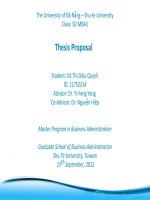


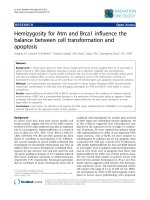

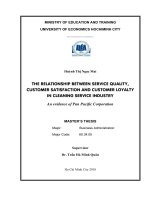
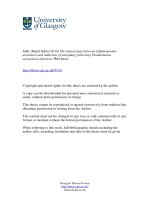
![brown and calor - 2004 - the correlation between corporate governance and company performance [cgs-fp]](https://media.store123doc.com/images/document/2015_01/02/medium_izzlTXr0MM.jpg)
